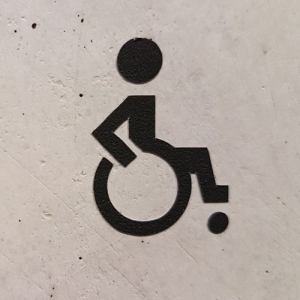Designing Disabled Toilets: Your Guide to Accessible Toilet Specifications

Within the UK, all venues are required by law to provide wheel-chair accessible toilets. The guidelines for such are laid out in Document M of the UK building regulations.
Ensuring accessibility in public spaces is not just a legal requirement, but allows people with disabilities to exercise their independence and allow them their dignity when in public spaces. In this blog, we will delve into the essential specifications for designing disabled toilets that cater to a diverse range of needs.
Get in touch to learn more about washroom accessibility
Disabled Toilets Layout and Dimensions
The law states that wheelchair users should be able to comfortably approach, enter, and use the designated toilet facilities, whether that be the one unisex wheelchair-accessible toilet required or part of a larger washroom. Considering the layout of the toilet is crucial, right down to the direction the door opens (outwards, to provide more space inside the toilet for the wheelchair). The most crucial thing to bear in mind is that wheelchair users will require plenty of floor space for turning and transferring from their chair to the toilet and back again. The recommended dimensions for this are 2200mm deep by 1500mm wide, however, the more space you provide, the easier access will be for wheelchair users. Don’t forget to consider that extra space may be needed for service animals or carers to assist people with disabilities.
It is important to note that the minimum dimensions exclude any space taken up by any items in the washroom, such as a baby changing table or free-standing hand dryer. When measuring your space, be sure to exclude the space used by other objects.
We’ve already mentioned considering your door direction, but you also need to think about the doorway itself - it needs to be wide enough to accommodate wheelchair users, and easy to open and lock for those who may have limited movement or dexterity, and therefore find operating handles and small locks difficult.
Both toilets themselves and other bathroom items, such as hand basins, need to be a suitable height for easy transfer between wheelchair and toilet. Some toilets offer adjustable heights in order to cater for a wide range of individuals, but at minimum, grab rails should be provided for support, specifically on either side of the toilet.
The Fixtures and Fittings
As well as the main toilet and washroom items, fixtures and fittings also need to be easily utilised by people with disabilities. Remember that the facilities will be used by individuals with an incredibly broad range of mobility impairments, from wheelchair users to those with a lower level of hand dexterity.
To accommodate as many of these users as possible, you must kit your washroom with the appropriate fixtures and fittings. Consider taps with lever handles, soap dispensers, and waste management facilities that are at an accessible height, and not taxing to use. As stated above, grab bars for extra support are a necessity, but you should also consider implementing emergency alarms to ensure anybody using your toilet can easily call for help.
It may be that you also need to consider adult changing facilities. An adult changing facility should include changing tables made to support a larger weight and hoists for transferring.
For more information on fixtures you may need, our team would be happy to assist.
Get Support with Disabled Toilet Design
Designing disabled toilets with careful consideration of these specifications goes beyond compliance, allowing people with disabilities greater freedom and respect. By embracing these guidelines, public spaces can ensure that everyone, regardless of their abilities, can access facilities with independence and comfort.
